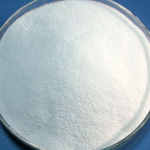Project Description
Trisodium Pyrophosphate
 Synonyms: Trisodium diphosphate; Trisodium pyrophosphate; Trisodium hydrogen diphosphate; Acid trisodium pyrophosphate; 3SP; TSAPP
Synonyms: Trisodium diphosphate; Trisodium pyrophosphate; Trisodium hydrogen diphosphate; Acid trisodium pyrophosphate; 3SP; TSAPP
CAS No.:14691-80-6
INS No.: E450(ii)
Einecs No.:238-735-6
Chemical Formula: Na3HP2O7
Molecular Weight:243.92
Properties: White powder.
Trisodium pyrophosphate hydrolyzes in an aqueous solution as the rate of hydrolysis increases with temperature. It is recommended to keep solutions below 40°C. Solubility is strongly affected by PH.
Trisodium pyrophosphate has the highest solubility of sodium pyrophosphates and has a neutral pH.
Conforms to EU Commission Regulation 231/2012 requirements and China’s national standard GB 2760. It is of mineral origin and is allergen and GMO-free.
| Item | Specification |
|---|---|
| Assay (Na3HP2O7) | 96% min. |
| P2O5 | 57-59% |
| PH value (1% water solution) | 6.7-7.5 |
| Loss on drying (105°C) | 0.5% max. |
| Loss on ignition (550°C) | 4.5% max. |
| Water insoluble matter | 0.2% max. |
| Bulk density | 0.85kg/cm3 |
| Heavy metal (as Pb) | 10mg/kg max. |
| Lead (as Pb) | 1mg/kg max. |
| Arsenic (as As) | 1mg/kg max. |
| Fluoride (as F) | 10mg/kg max. |
| Mercury (as Hg) | 1mg/kg max. |
| Cadmium (as Cd) | 1mg/kg max. |
Applications
Trisodium Pyrophosphate (E450(ii)) is primarily used as a food additive in the food industry. Its main application is as a sequestrant, pH regulator, and emulsifier. Here are the main applications of trisodium diphosphate (E450(ii)) in the food industry:
1. Sequestrant: Trisodium Pyrophosphate acts as a sequestrant by binding to metal ions, such as calcium, magnesium, and iron. This helps to prevent these metal ions from interfering with food processes, such as enzymatic reactions, oxidation, or discoloration. It helps improve processed food products’ stability, quality, and appearance.
2. pH regulator: Trisodium Pyrophosphate is also used as a pH regulator in various food applications. It can be used to adjust and control food products’ acidity or alkalinity levels, ensuring the desired pH for taste, preservation, or processing purposes.
3. Emulsifier: Trisodium Pyrophosphate acts as an emulsifier in food products, aiding in the uniform dispersion of fats and oils in water-based systems. It helps to stabilize emulsions, preventing phase separation and improving the texture and mouthfeel of products such as salad dressings, sauces, and processed cheese.
4. Texture improvement: Trisodium Pyrophosphate can enhance the texture of food products by improving water binding and moisture retention. It helps to prevent drying out and maintain the juiciness or tenderness of processed meats, poultry, and seafood.
Trisodium Pyrophosphate food-grade shows more rapid solubility in cold and pre-salted brines than other disodium acid pyrophosphate and sodium pyrophosphates and higher yields in the finished products compared to traditional blends of disodium and tetrasodium diphosphates. It is suitable for use in applications where a highly soluble source of pyrophosphate is required. PH of its solution is about neutral.
For more details, please visit this blog What is the Use of Trisodium Pyrophosphate?
Packaging
25 kg/bag inner plastic and outer laminated high-density woven bag or paper sack. Also, provide packages according to customer’s requirements.
Storage
Trisodium pyrophosphate should be stored in cool, dry conditions and a well-ventilated place. The use of warehouse racking or single stacking of pallets is also advisable.
Shelf life
24 months from the date of manufacture, assuming correct storage conditions and undamaged packaging.
Health and Safety Information
Trisodium pyrophosphate is not classified as a hazardous substance.

